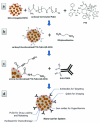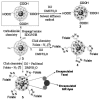Enabling anticancer therapeutics by nanoparticle carriers: the delivery of Paclitaxel
- PMID: 21845085
- PMCID: PMC3155358
- DOI: 10.3390/ijms12074395
Enabling anticancer therapeutics by nanoparticle carriers: the delivery of Paclitaxel
Abstract
Anticancer drugs, such as paclitaxel (PTX), are indispensable for the treatment of a variety of malignancies. However, the application of most drugs is greatly limited by the low water solubility, poor permeability, or high efflux from cells. Nanoparticles have been widely investigated to enable drug delivery due to their low toxicity, sustained drug release, molecular targeting, and additional therapeutic and imaging functions. This review takes paclitaxel as an example and compares different nanoparticle-based delivery systems for their effectiveness in cancer chemotherapy.
Keywords: anticancer drugs; drug carrier; drug delivery; nanomaterials; paclitaxel.
Figures









Similar articles
-
Self-assembled hybrid nanoparticles for targeted co-delivery of two drugs into cancer cells.Chem Commun (Camb). 2014 Mar 21;50(23):3103-5. doi: 10.1039/c3cc49003c. Chem Commun (Camb). 2014. PMID: 24516863 Free PMC article.
-
Synthesis, characterization, and evaluation of paclitaxel loaded in six-arm star-shaped poly(lactic-co-glycolic acid).Int J Nanomedicine. 2013;8:4315-26. doi: 10.2147/IJN.S51629. Epub 2013 Nov 7. Int J Nanomedicine. 2013. PMID: 24235829 Free PMC article.
-
Developing combination of artesunate with paclitaxel loaded into poly-d,l-lactic-co-glycolic acid nanoparticle for systemic delivery to exhibit synergic chemotherapeutic response.Drug Dev Ind Pharm. 2017 Dec;43(12):1952-1962. doi: 10.1080/03639045.2017.1357729. Epub 2017 Aug 3. Drug Dev Ind Pharm. 2017. PMID: 28724314
-
Protein-based nanocarriers for paclitaxel (PTX) delivery in cancer treatment: A review.Int J Biol Macromol. 2025 May;310(Pt 1):143068. doi: 10.1016/j.ijbiomac.2025.143068. Epub 2025 Apr 11. Int J Biol Macromol. 2025. PMID: 40220831 Review.
-
Recent Development of Copolymeric Nano-Drug Delivery System for Paclitaxel.Anticancer Agents Med Chem. 2020;20(18):2169-2189. doi: 10.2174/1871520620666200719001038. Anticancer Agents Med Chem. 2020. PMID: 32682385 Review.
Cited by
-
Nanoparticles as Drug Delivery Systems of RNAi in Cancer Therapy.Molecules. 2021 Apr 19;26(8):2380. doi: 10.3390/molecules26082380. Molecules. 2021. PMID: 33921892 Free PMC article. Review.
-
Paclitaxel-conjugated PAMAM dendrimers adversely affect microtubule structure through two independent modes of action.Biomacromolecules. 2013 Mar 11;14(3):654-64. doi: 10.1021/bm301719b. Epub 2013 Feb 21. Biomacromolecules. 2013. PMID: 23391096 Free PMC article.
-
Novel targeted system to deliver chemotherapeutic drugs to EphA2-expressing cancer cells.J Med Chem. 2012 Mar 8;55(5):2427-36. doi: 10.1021/jm201743s. Epub 2012 Feb 27. J Med Chem. 2012. PMID: 22329578 Free PMC article.
-
Enhancement of anticancer efficacy using modified lipophilic nanoparticle drug encapsulation.Int J Nanomedicine. 2012;7:731-7. doi: 10.2147/IJN.S28783. Epub 2012 Feb 10. Int J Nanomedicine. 2012. PMID: 22359452 Free PMC article.
-
Effect of Size and Concentration of PLGA-PEG Nanoparticles on Activation and Aggregation of Washed Human Platelets.Pharmaceutics. 2019 Oct 4;11(10):514. doi: 10.3390/pharmaceutics11100514. Pharmaceutics. 2019. PMID: 31590303 Free PMC article.
References
-
- Lopes NM, Adams EG, Pitts TW, Bhuyan BK. Cell kill kinetics and cell cycle effects of taxol on human and hamster ovarian cell lines. Cancer Chemother. Pharmacol. 1993;32:235–242. - PubMed
-
- Rowinsky EK, Cazenave LA, Donehower RC. Taxol: A novel investigational antimicrotubule agent. J. Natl. Cancer. 1990;82:1247–1259. - PubMed
-
- Jordan MA, Wilson L. Microtubules as a target for anticancer drugs. Nat. Rev. Cancer. 2004;4:253–265. - PubMed
-
- Mugabe C, Hadaschik BA, Kainthan RK, Brooks DE, So AI, Gleave ME, Burt HM. Paclitaxel incorporated in hydrophobically derivatized hyperbranched polyglycerols for intravesical bladder cancer therapy. BJU Int. 2009;103:978–986. - PubMed
Publication types
MeSH terms
Substances
LinkOut - more resources
Full Text Sources
Other Literature Sources

